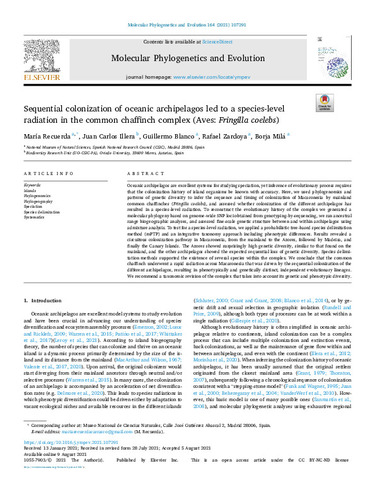Sequential colonization of oceanic archipelagos led to a species-level radiation in the common chaffinch complex (Aves: Fringilla coelebs)
Autor(es) y otros:
Fecha de publicación:
Versión del editor:
Citación:
Resumen:
Oceanic archipelagos are excellent systems for studying speciation, yet inference of evolutionary process requires that the colonization history of island organisms be known with accuracy. Here, we used phylogenomics and patterns of genetic diversity to infer the sequence and timing of colonization of Macaronesia by mainland common chaffinches (Fringilla coelebs), and assessed whether colonization of the different archipelagos has resulted in a species-level radiation. To reconstruct the evolutionary history of the complex we generated a molecular phylogeny based on genome-wide SNP loci obtained from genotyping-by-sequencing, we ran ancestral range biogeographic analyses, and assessed fine-scale genetic structure between and within archipelagos using admixture analysis. To test for a species-level radiation, we applied a probabilistic tree-based species delimitation method (mPTP) and an integrative taxonomy approach including phenotypic differences. Results revealed a circuitous coloni ...
Oceanic archipelagos are excellent systems for studying speciation, yet inference of evolutionary process requires that the colonization history of island organisms be known with accuracy. Here, we used phylogenomics and patterns of genetic diversity to infer the sequence and timing of colonization of Macaronesia by mainland common chaffinches (Fringilla coelebs), and assessed whether colonization of the different archipelagos has resulted in a species-level radiation. To reconstruct the evolutionary history of the complex we generated a molecular phylogeny based on genome-wide SNP loci obtained from genotyping-by-sequencing, we ran ancestral range biogeographic analyses, and assessed fine-scale genetic structure between and within archipelagos using admixture analysis. To test for a species-level radiation, we applied a probabilistic tree-based species delimitation method (mPTP) and an integrative taxonomy approach including phenotypic differences. Results revealed a circuitous colonization pathway in Macaronesia, from the mainland to the Azores, followed by Madeira, and finally the Canary Islands. The Azores showed surprisingly high genetic diversity, similar to that found on the mainland, and the other archipelagos showed the expected sequential loss of genetic diversity. Species delimitation methods supported the existence of several species within the complex. We conclude that the common chaffinch underwent a rapid radiation across Macaronesia that was driven by the sequential colonization of the different archipelagos, resulting in phenotypically and genetically distinct, independent evolutionary lineages. We recommend a taxonomic revision of the complex that takes into account its genetic and phenotypic diversity.
ISSN:
Patrocinado por:
The research was funded by Spain’s Ministry of Science grants CGL2015-66381P, PGC-2018-098897-B-I00, and PGC2018-097575-B-I00. MR was supported by a doctoral fellowship from the Spanish Ministry of Education, Culture, and Sport (FPU16/05724), and JCI was funded by a GRUPIN research grant from the Regional Government of Asturias (Ref.: IDI/2018/000151).
Colecciones
- Artículos [37357]
- Biología de Organismos y Sistemas [752]
- Investigaciones y Documentos OpenAIRE [8242]
Ficheros en el ítem





